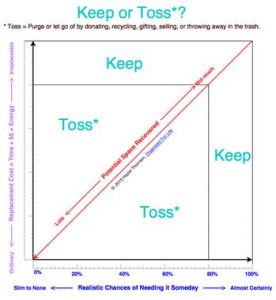Keep or Toss? “But I might need it someday!”
Organizing and decluttering go hand in hand.
Sometimes the choice to keep or toss something is easy: I love it! I use it! I need to keep it! OK, obviously a keeper. Put it away, or create a home for it.
Sometimes it’s not so easy, though: But it was a gift…but I paid a lot of money for it…I can’t decide…sigh…
What do I hear most often from clients? “But I might need it someday!”
Well, yes, you might. Or maybe not. Let’s think about that for a moment.
Ask yourself these three questions:
- What are the realistic chances that I will need this someday? (If you don’t know, just take a guess. 20% is a fairly low probability. 80% is getting closer to certainty.)
- What is the replacement cost of that item? (Consider the time involved, the financial cost, and the energy required. Do not use numbers, just use your gut.)
- How much space would be recovered if you were to let it go? (If the item is tiny, the incentive to let it go is reduced. We want the biggest bang for our decluttering buck!)
One more question:
What is the worst thing that might happen if I needed this someday and no longer had it?
If you still can’t decide:
How much is your clutter costing you to keep?
For those who enjoy and relate to visual aids, and because I can’t help my little engineering self, here it is in chart form, followed by a few examples (scroll down a bit, past the big blank space):
 Examples:
Examples:
Camping equipment: Somewhat expensive to replace, but your chances of ever going camping again are only about 10% due to your current age and health issues. Plus it takes up a lot of space that could be used for something else. And you would rather stay in a cabin, if you’re being honest. TOSS (If it turns out that the camping equipment has deteriorated after being stored in a hot garage for decades, the decision becomes that much easier.)
Empty boxes and plastic or paper bags: Easy and cheap to replace. Difficult, in fact, to keep them from accumulating without a system in place. Space potentially freed up = a whole kitchen cupboard plus 50 cu. ft. in the garage. Chances of needing them again, though, are nearly 100%. So, can you manage with fewer? Say, a bag of bags and a box of boxes? KEEP a limited quantity, and TOSS the rest!
Sewing Supplies: Leftover scraps and materials from former sewing and quilting projects. Half finished projects you started decades ago. Yes, you could finish them, but ask yourself Is it Really Worth Doing? Chances of needing the scraps again, or wanting to finish the projects is only 20% because, for one thing, you are really more interested these days in making jewelry and would like to free up more space for that. TOSS
Sewing Machine: No, you don’t sew much anymore. But you do use it occasionally for clothing repairs and alterations. It’s cheaper than hiring a tailor each time you need one. You have the space for it. KEEP.
Does this help you decide? Please leave a comment and let me know!
—————————————————————————
Copyright 2015 by Hazel Thornton, Organized For Life.
Social media links directly to this page are encouraged!
Please contact me for other types of reprint permission.
—————————————————————————
Share this:








I love your “little engineering self!” My husband is an engineer and I may need to show him this graph in regards to his wood scraps and tools!
Let me know if it helps him get rid of stuff, OK?
I’ll never forget the stash–very LARGE stash–of fabric that I gave away before a move several years ago. Each yardage purchased with a wonderful garment in mind to make for myself or someone else. Must have been thousands of dollars’ worth. It was a hard decision, but made using your question–how likely am I to ever use all this? The answer gave me permission to let it go.
Funny, even as an organizer, I sometimes fall into the same habits as my clients. 🙂
I too, fall into the same habits as my clients. Sometimes I look around and say, “Well? What would you tell a client to do about this?” And that’s what I do! 😉
Very nice, Hazel. This is exactly how my brain works!
🙂
What’s most eye-opening is that there are very few situations that end up in the “Keep” section. Maybe the secret is: if you aren’t sure if you need it, you probably don’t.
Yep. Of course, the 80% benchmark is my own…a nod to the famous 80/20 rule. I just did the math: if your stuff was evenly distributed on the chart (which, of course, it isn’t), and you followed the Keep/Toss lines religiously (which is unlikely), you would be Tossing 64% of your stuff and Keeping 36%. This is only the “But I might need it someday!” stuff, mind you. There will be plenty of Keep-for-sures and Toss-for-sures that don’t require a chart’s input!
It’s great to see the mental process in a visual way. Thanks!
Glad it also makes sense to others!
Hazel, you’ve been looking into my closets again, haven’t you! Time to get out those fabric pieces and let someone else put them to good use…
Ha ha….well, it’s been a few days….have you done it yet? Thanks for commenting, Anita!
I (usually) have a logical approach to life, but my stuff defies logic.I struggle with the “I might need it someday” syndrome. Your three questions help take the emotional attachment out of the equation. And helps me get back to logical thinking.
I’m so glad you found them helpful!